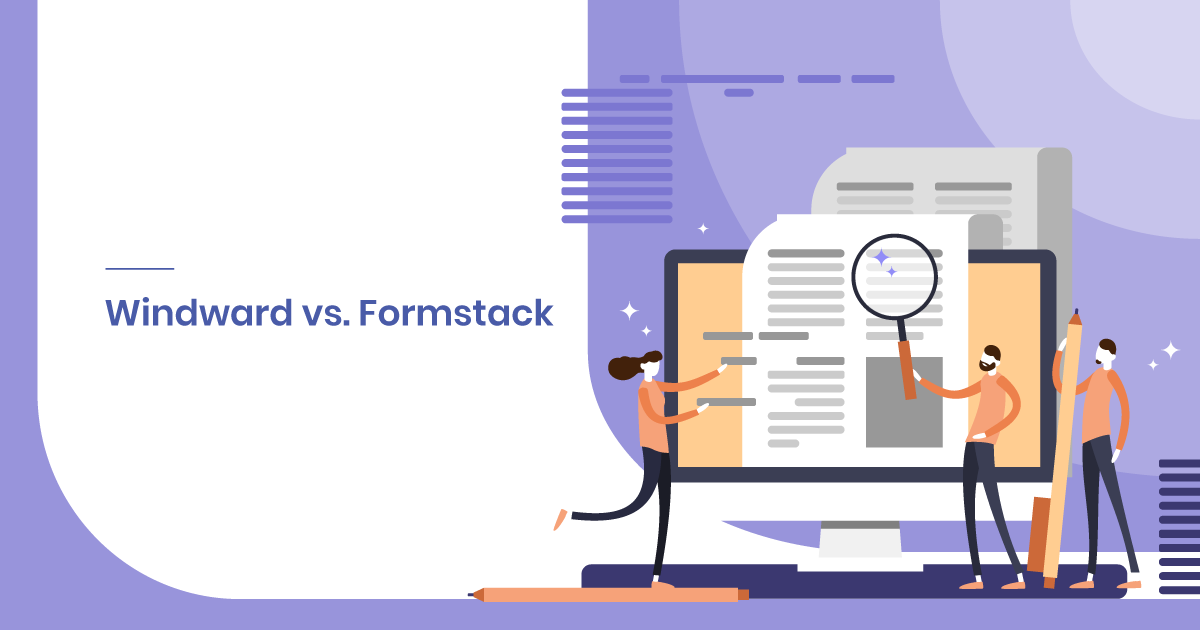If you’re working with a considerable volume of documents regularly, it’s helpful to familiarize yourself with the document automation tools out there in the market. While they help to create and manage countless documents in a snap, choosing from a plethora of DocAuto tools and its varying list of vendors might confuse you.
However, Windward and Formstack (formerly WebMerge) are two of the most popular document automation solution providers that you might like to consider while making the decision. Right from creating powerful documents to streamlining your document generation process, both of these DocGen solutions make document generation hassle-free and painless.
Here’s a showdown of Windward and Formstack along with a brief comparison of their features, functionalities, and pros & cons to help you make the right decision.
Windward vs. Formstack: Which is better?
1. Building Templates
The first step to creating documents with any DocGen tools is building templates. You can then use these templates in generating documents of similar types or produce a new document with just a minor alteration in the existing template.
With Formstack’s document builder, you need to first enter merge fields to fetch the data you want. Also, it requires you to follow a specific format. However, Formstack also lets you place the data directly on the document using merge fields, but unfortunately, it does not say how you can assign the data to merge fields; thus, making the process quite complicated.
On the contrary, Windward fetches data from the required sources seamlessly. All you need to do is connect it with the specific datasource, be it Salesforce or any business applications you use.
2. Document Delivery
Formstack is power-packed with a pool of document delivery options. That is, you can send your documents directly to the desired recipients right from Formstack. Different options that it offers include CRM, Doc Storage, eSignature, email, and more. You can also create multiple deliveries of a single document with Formstack.
Windward has add-ons like Windward Core and Windward Hub that enables you to deliver your document via your application, save, or email it. It works based on the delivery method you opt for.
3. Data Sources
On the one hand, where Windward supports multiple datasources, on the other, Formstack lets you pull data from various sources with its ‘Merge’ functionality. But again, Formstack has no explicit mention of what merge is and how it functions. Though it seems that Formstack has got essential features to make document generation easier, it has not enough documentation for users to leverage the benefits.
4. Custom Online Forms
You can create online forms with Formstack in just a few minutes – without the help of your developers. Yes, Formstack has made this possible. It has got an easy website form builder with advanced features that help you create a custom form within a few clicks. Right from collecting payments to gathering data, it automates your routine tasks and lets you focus on other crucial activities.
On the contrary, you don’t get any such privileged functionality from Windward, but yes, you can still create forms like other documents with no hassles.
Windward & Formstack At A Glance
| Features |  |
 |
|---|---|---|
| Code Behind | It requires you to map fields | No Code Behind |
| Drag and Drop | You don’t have access to any such functionality | It supports drag and drop throughout the platform |
| Multiple Datasources | Merging data from multiple sources is cumbersome | It easily fetches data from multiple sources |
| Validation, Error & Warning Handling | If something goes wrong, finding the error is tough | You can easily detect errors and warnings |
| Time Zone | It lets you select time zone while uploading any document; thus, making document generation including timestamp data easier | There’s no such functionality available |
| Document Status | You can define the status of your document as – Active, Test Mode, and Inactive | There are no predefined modes, wherein you can put your documents. But you can preview them before finalizing |
| Conditional Statements | It supports only ‘if’ tag | It supports ‘if’ and ‘else’ tags along with 12+ other tags |
| Output Format | CSV, DOCX, HTML, PDF, PPTX, RTF, and XLSX | You can have the output in every format you desire |
| Pros & Cons |
|
|
Final Thoughts
If you are a newbie to document generation, Formstack is created right for you. Whether you talk about its friendly user interface or explanatory features, it guides you through every step of your document creation. While time zone and document status are its unique functionalities, it masters the art of form building.
When it comes to Windward, it has got all the advanced features that one might desire to have in a DocGen tool, but if your needs are limited, it might turn out to be costly. On the other hand, it is ultimately “no-code” platform, i.e., whether you are a tech expert or lack technical knowledge, Windward works equally for you – it neither requires you to code nor write any queries. All you have to do is drag and drop data fields, and Windward will generate code on its own.
While both come with its perks and drawbacks, it solely depends on your requirements to pick the best-suited one.
Want to ensure you make the right decision? Well, you can check out the detailed reviews of Windward and Formstack here.
Need Any Technology Assistance? Call Pursho @ 0731-6725516




